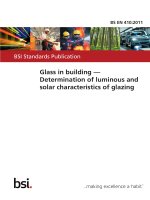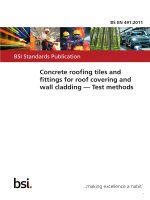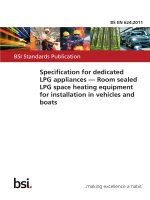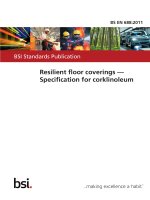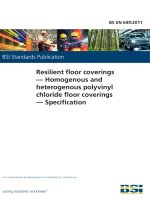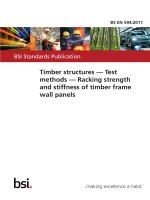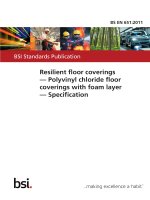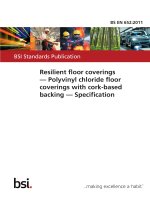Bsi bs en 61307 2011
Bạn đang xem bản rút gọn của tài liệu. Xem và tải ngay bản đầy đủ của tài liệu tại đây (985 KB, 20 trang )
BS EN 61307:2011
BSI Standards Publication
Industrial microwave heating
installations — Test methods
for the determination of power
output
BS EN 61307:2011
BRITISH STANDARD
National foreword
This British Standard is the UK implementation of EN 61307:2011. It is
identical to IEC 61307:2011. It supersedes BS EN 61307:2006 which is
withdrawn.
The UK participation in its preparation was entrusted to Technical
Committee PEL/27, Electroheating.
A list of organizations represented on this committee can be obtained
on request to its secretary.
This publication does not purport to include all the necessary provisions
of a contract. Users are responsible for its correct application.
© BSI 2011
ISBN 978 0 580 70047 7
ICS 25.180.10
Compliance with a British Standard cannot confer immunity from
legal obligations.
This British Standard was published under the authority of the Standards
Policy and Strategy Committee on 31 August 2011.
Amendments issued since publication
Date
Text affected
BS EN 61307:2011
EUROPEAN STANDARD
EN 61307
NORME EUROPÉENNE
July 2011
EUROPÄISCHE NORM
ICS 25.180.10
Supersedes EN 61307:2006
English version
Industrial microwave heating installations Test methods for the determination of power output
(IEC 61307:2011)
Installations industrielles de chauffage à
hyperfréquence Méthodes d'essai pour la détermination de
la puissance de sortie
(CEI 61307:2011)
Industrielle MikrowellenErwärmungsanlagen Messverfahren für die Bestimmung der
Ausgangsleistung
(IEC 61307:2011)
This European Standard was approved by CENELEC on 2011-06-22. CENELEC members are bound to comply
with the CEN/CENELEC Internal Regulations which stipulate the conditions for giving this European Standard
the status of a national standard without any alteration.
Up-to-date lists and bibliographical references concerning such national standards may be obtained on
application to the Central Secretariat or to any CENELEC member.
This European Standard exists in three official versions (English, French, German). A version in any other
language made by translation under the responsibility of a CENELEC member into its own language and notified
to the Central Secretariat has the same status as the official versions.
CENELEC members are the national electrotechnical committees of Austria, Belgium, Bulgaria, Croatia, Cyprus,
the Czech Republic, Denmark, Estonia, Finland, France, Germany, Greece, Hungary, Iceland, Ireland, Italy,
Latvia, Lithuania, Luxembourg, Malta, the Netherlands, Norway, Poland, Portugal, Romania, Slovakia, Slovenia,
Spain, Sweden, Switzerland and the United Kingdom.
CENELEC
European Committee for Electrotechnical Standardization
Comité Européen de Normalisation Electrotechnique
Europäisches Komitee für Elektrotechnische Normung
Management Centre: Avenue Marnix 17, B - 1000 Brussels
© 2011 CENELEC -
All rights of exploitation in any form and by any means reserved worldwide for CENELEC members.
Ref. No. EN 61307:2011 E
BS EN 61307:2011
EN 61307:2011
-2-
Foreword
The text of document 27/761/CDV, future edition 3 of IEC 61307, prepared by IEC TC 27, Industrial
electroheating, was submitted to the IEC-CENELEC parallel vote and was approved by CENELEC as
EN 61307 on 2011-06-22.
This European Standard supersedes EN 61307:2006.
EN 61307:2011 includes the following significant technical changes with respect to EN 61307:2006:
a) it covers how to measure not only the microwave power output of all typical equipment designs, but
also the system efficiency, including the standby and hibernation modes;
b) the handling of the former A and B types of equipment is replaced by measurements of the available
microwave power output and microwave workload power, respectively.
Attention is drawn to the possibility that some of the elements of this document may be the subject of
patent rights. CEN and CENELEC shall not be held responsible for identifying any or all such patent
rights.
The following dates were fixed:
– latest date by which the EN has to be implemented
at national level by publication of an identical
national standard or by endorsement
(dop)
2012-03-22
– latest date by which the national standards conflicting
with the EN have to be withdrawn
(dow)
2014-06-22
Annex ZA has been added by CENELEC.
__________
Endorsement notice
The text of the International Standard IEC 61307:2011 was approved by CENELEC as a European
Standard without any modification.
In the official version, for Bibliography, the following notes have to be added for the standards indicated:
IEC 60335-2-25
NOTE Harmonized as EN 60335-2-25.
IEC 60335-2-90
NOTE Harmonized as EN 60335-2-90.
IEC 60705
NOTE Harmonized as EN 60705.
IEC 61010-2-010
NOTE Harmonized as EN 61010-2-010.
__________
BS EN 61307:2011
-3-
EN 61307:2011
Annex ZA
(normative)
Normative references to international publications
with their corresponding European publications
The following referenced documents are indispensable for the application of this document. For dated
references, only the edition cited applies. For undated references, the latest edition of the referenced
document (including any amendments) applies.
NOTE When an international publication has been modified by common modifications, indicated by (mod), the relevant EN/HD
applies.
Publication
Year
Title
EN/HD
Year
IEC 60050-221
+ A1
+ A2
+ A3
1990
1993
1999
2007
International Electrotechnical Vocabulary Chapter 221: Magnetic materials and
components
-
-
IEC 60050-726
1982
International Electrotechnical Vocabulary Chapter 726: Transmission lines and
waveguides
-
-
IEC 60050-841
2004
International Electrotechnical Vocabulary Part 841: Industrial electroheat
-
-
IEC 60519-6
-
Safety in electroheat installations Part 6: Specifications for safety in industrial
microwave heating equipment
EN 60519-6
-
BS EN 61307:2011
–2–
61307 IEC:2011
CONTENTS
1
FOREWORD .................................................................................................................... 3
1
Scope ............................................................................................................................... 5
2
Normative references ....................................................................................................... 5
3
Terms and definitions ....................................................................................................... 5
4
Methods of microwave power measurements .................................................................... 8
5
4.1 General ................................................................................................................... 8
4.2 Available microwave power output ........................................................................... 8
4.3 Microwave workload power ...................................................................................... 8
4.4 Effective microwave power and efficiency ................................................................ 9
Calorimetric power measurements .................................................................................... 9
6
5.1 General ................................................................................................................... 9
5.2 Direct water power measurements ........................................................................... 9
5.3 Dummy load power measurements ........................................................................ 10
Determination of microwave workload power .................................................................. 10
7
Determination of effective microwave power ................................................................... 11
8
7.1 General ................................................................................................................. 11
7.2 The open container water test ............................................................................... 11
7.3 Tests using other liquids ........................................................................................ 12
Electrical efficiency ........................................................................................................ 12
9
8.1 Available microwave power output ......................................................................... 12
8.2 Electric input ......................................................................................................... 13
Standby power consumption ........................................................................................... 13
Bibliography .......................................................................................................................... 14
BS EN 61307:2011
61307 IEC:2011
–3–
INTERNATIONAL ELECTROTECHNICAL COMMISSION
____________
INDUSTRIAL MICROWAVE HEATING INSTALLATIONS –
TEST METHODS FOR THE DETERMINATION
OF POWER OUTPUT
FOREWORD
1) The International Electrotechnical Commission (IEC) is a worldwide organization for standardization comprising
all national electrotechnical committees (IEC National Committees). The object of IEC is to promote
international co-operation on all questions concerning standardization in the electrical and electronic fields. To
this end and in addition to other activities, IEC publishes International Standards, Technical Specifications,
Technical Reports, Publicly Available Specifications (PAS) and Guides (hereafter referred to as “IEC
Publication(s)”). Their preparation is entrusted to technical committees; any IEC National Committee interested
in the subject dealt with may participate in this preparatory work. International, governmental and nongovernmental organizations liaising with the IEC also participate in this preparation. IEC collaborates closely
with the International Organization for Standardization (ISO) in accordance with conditions determined by
agreement between the two organizations.
2) The formal decisions or agreements of IEC on technical matters express, as nearly as possible, an international
consensus of opinion on the relevant subjects since each technical committee has representation from all
interested IEC National Committees.
3) IEC Publications have the form of recommendations for international use and are accepted by IEC National
Committees in that sense. While all reasonable efforts are made to ensure that the technical content of IEC
Publications is accurate, IEC cannot be held responsible for the way in which they are used or for any
misinterpretation by any end user.
4) In order to promote international uniformity, IEC National Committees undertake to apply IEC Publications
transparently to the maximum extent possible in their national and regional publications. Any divergence
between any IEC Publication and the corresponding national or regional publication shall be clearly indicated in
the latter.
5) IEC itself does not provide any attestation of conformity. Independent certification bodies provide conformity
assessment services and, in some areas, access to IEC marks of conformity. IEC is not responsible for any
services carried out by independent certification bodies.
6) All users should ensure that they have the latest edition of this publication.
7) No liability shall attach to IEC or its directors, employees, servants or agents including individual experts and
members of its technical committees and IEC National Committees for any personal injury, property damage or
other damage of any nature whatsoever, whether direct or indirect, or for costs (including legal fees) and
expenses arising out of the publication, use of, or reliance upon, this IEC Publication or any other IEC
Publications.
8) Attention is drawn to the Normative references cited in this publication. Use of the referenced publications is
indispensable for the correct application of this publication.
9) Attention is drawn to the possibility that some of the elements of this IEC Publication may be the subject of
patent rights. IEC shall not be held responsible for identifying any or all such patent rights.
International Standard IEC 61307 has been prepared by IEC technical committee 27:
Industrial electroheating.
This third edition cancels and replaces the second edition published in 2006. It constitutes a
technical revision .
This edition includes the following significant technical changes with respect to the previous
edition:a) it covers how to measure not only the microwave power output of all typical equipment
designs, but also the system efficiency, including the standby and hibernation modes;
b) the handling of the former A and B types of equipment is replaced by measurements of the
available microwave power output and microwave workload power, respectively.
BS EN 61307:2011
61307 IEC:2011
–4–
The text of this standard is based on the following documents:
CDV
Report on voting
27/761/CDV
27/782/RVC
Full information on the voting for the approval of this standard can be found in the report on
voting indicated in the above table.
This publication has been drafted in accordance with the ISO/IEC Directives, Part 2.
The committee has decided that the contents of this publication will remain unchanged until
the stability date indicated on the IEC web site under "" in the data
related to the specific publication. At this date, the publication will be
•
•
•
•
reconfirmed,
withdrawn,
replaced by a revised edition, or
amended.
BS EN 61307:2011
61307 IEC:2011
–5–
INDUSTRIAL MICROWAVE HEATING INSTALLATIONS –
TEST METHODS FOR THE DETERMINATION
OF POWER OUTPUT
1
Scope
This International Standard specifies test methods for the determination of the available
microwave output power and the efficiency of frequency conversion from the electrical input in
industrial microwave heating installations.
This standard also specifies test methods for assessing the microwave power deposition in
the microwave workload – the microwave workload power, in microwave-only installations.
This standard is applicable to industrial microwave heating equipment and installations in the
frequency range from 300 MHz to 300 GHz.
This standard relates to industrial microwave heating equipment operating under normal load.
This standard does not apply to appliances for household and similar use (covered by
IEC 60335-2-25), commercial use (covered by IEC 60335-2-90) or laboratory use (covered by
IEC 61010-2-010).
2
Normative references
The following referenced documents are indispensable for the application of this document.
For dated references, only the edition cited applies. For undated references, the latest edition
of the referenced document (including any amendments) applies.
IEC 60050-221:1990, International Electrotechnical Vocabulary – Chapter 221: Magnetic
materials and components
Amendment 1(1993)
Amendment 2 (1999)
Amendment 3 (2007)
IEC 60050-841:2004,
electroheat
International
Electrotechnical
Vocabulary
–
Part
841:
Industrial
IEC 60050-726:1982, International Electrotechnical Vocabulary – Chapter 726: Transmission
lines and waveguides
IEC 60519-6, Safety in electroheat installations – Part 6: Specifications for safety in industrial
microwave heating equipment
3
Terms and definitions
For the purposes of this document, the terms and definitions of IEC 60519-6 and
IEC 60050-841 as well as the following apply.
3.1
calorimetric power meter
calorimeter power meter
power meter which uses temperature rise in a medium as a means of measuring absorbed
power
BS EN 61307:2011
–6–
61307 IEC:2011
NOTE The medium, typically water, is either the power-absorbing agent or has heat transferred to it from a
power-absorbing element.
[IEC 60050-726:1982, 726-21-10]
3.2
circulator
passive device having three or more ports in which the power entering any port is transmitted
to the next port according to a given order of sequence
NOTE The typical forms are junction circulators [IEC 60050-221:1990, 221-05-14]
[IEC 60050-726:1982, 726-17-12] or Y junction [IEC 60050-726:1982, 726-17-13].
of
the
T
junction
[IEC 60050-221:1990, 221-05-11, modified]
3.3
cross coupling (between generators)
appearance of undesired microwave energy in a microwave generator or the transmission line
output port of a microwave generator assembly caused by one or several other microwave
generators or microwave generator assemblies
3.4
electrical efficiency of microwave heating equipment
quotient between the available microwave power output and the electric input to the mains
frequency power supply or microwave generator assembly, at power settings for normal
operation
3.5
insertion loss
loss resulting from the insertion of a network into a transmission system, the ratio of the
power delivered to that part of the system following the network, before insertion of the
network, to the power delivered to that same part after insertion of the network
NOTE
The insertion loss is generally expressed in decibels.
[IEC 60050-726:1982, 726-06-07]
3.6
isolation (of a three-port circulator)
reverse attenuation between the main output port and main input port, with all ports being
impedance matched
NOTE 1
The isolation should not be confused with the reverse loss occurring between adjacent ports.
NOTE 2
This is a special case of cross coupling of a circulator [IEC 60050-726:1982, 726-16-06].
3.7
means of access
all structural features of the microwave heating equipment which can be opened or removed
without the use of a tool to provide access to the interior of the microwave applicator or
microwave cavity
3.8
microwave applicator
structure which applies the microwave energy to the load
[IEC 60050-841:2004, 841-29-11]
3.9
microwave cavity
space enclosed by inner metal walls and a door or an access opening and in which the
microwave load is placed
BS EN 61307:2011
61307 IEC:2011
–7–
[IEC 60050-841:2004, 841-29-19, modified]
3.10
microwave enclosure
structure which is intended to confine the microwave energy to a defined region
NOTE
Examples are a cavity, door seals and waveguides.
[IEC 60050-841:2004, 841-29-20]
3.11
microwave generator
source used to produce electromagnetic energy in the frequency range from 300 MHz to
300 GHz
[IEC 60050-841:2004, 841-29-16]
NOTE In the context of this standard, the microwave generator is only the component where the frequency
conversion takes place. See 3.2.
3.12
microwave generator assembly
part of the microwave heating equipment comprising an apparatus producing microwave
energy and its associated transmission line output port
NOTE 1 The assembly includes the microwave generator, the power supply of the microwave generator and its ancillary
and control circuits. If a circulator is used, it is also included.
NOTE 2 Microwave heating equipment containing a microwave generator assembly was classified as Type A in
earlier editions of this standard; equipment where a transmission line output port is not available was classified as
Type B.
3.13
microwave heating equipment
assembly of electric and mechanical devices intended for the transfer of microwave energy to
the microwave load and comprising in general power supplies, microwave generators or
microwave generator assemblies with cooling arrangements and circulators if used,
microwave applicators or cavities with ventilation arrangements if used, interconnecting
cables and waveguides, control circuitry, and means for transporting the microwave load if
used
[IEC 60050-841:2004, 841-29-06, modified]
3.14
microwave load
objects introduced into the applicator or cavity, or put in the intended position near an open
applicator
[IEC 60050-841:2004, 841-29-12]
3.15
microwave transparency
property of a material having negligible absorption and reflection of microwaves
NOTE The relative permittivity of a microwave transparent material is usually less than 7 and the loss factor is
usually less than 0,015. However, if the microwave workload has a low loss factor, more stringent requirements
apply.
[IEC 60050-841:2004, 841-29-14, modified]
3.16
microwave workload
object to be treated by microwaves
BS EN 61307:2011
–8–
61307 IEC:2011
[IEC 60050-841:2004, 841-29-13]
NOTE
Workload containers are not a part of the microwave workload but of the microwave load.
3.17
normal load
nominal microwave load at full microwave output power as specified by the manufacturer's
documentation
3.18
normal operation
range of microwave output power with the normal loads in allowable working conditions of the
microwave heating equipment, as specified by the manufacturer's documentation
3.19
standby (mode of) operation
condition allowing immediate normal operation
NOTE 1
This mode typically occurs immediately before and after normal operation.
NOTE 2 If the treatment of the workload requires non-ambient conditions such as elevated temperature, this is
maintained.
NOTE 3 By "immediate" is meant a time period consistent with normal loading, unloading or replacement of the
workload.
NOTE 4
4
4.1
The magnetron cathode heater circuit may be switched on in this mode of operation.
Methods of microwave power measurements
General
Three different methods are described. Their applicability depends on the microwave
frequency and power level, and if the equipment comprises a microwave generator assembly.
NOTE 1 Since the wavelength of frequencies above about 20 GHz is very short, the power deposition may be of
the irradiation type with a short penetration depth. Water may not be useable with the calorimetric method, and
some of the methods of measuring microwave power deposition in this standard may not be applicable. In the low
end of the microwave band at 300 MHz, the microwave absorption capability of loads may be highly variable during
the heating process, large load masses may be needed, and representative artificial liquid loads for calorimetry
may be difficult to use.
NOTE 2 There are variabilities of the microwave absorption capability of microwave loads, and in particular the
unevenness of heating of these. Therefore, the microwave workload power data or the effective microwave power
data with a substitute liquid load obtained according to this standard should be treated with care. Power data is,
however, important and objective factors related to the overall energy utilisation efficiency are by that also a
performance factor.
NOTE 3 A method for measuring the microwave power output in household microwave ovens is specified in
IEC 60705. It uses a large water load, with compensation of heat capacity of the container and of heat exchange
with ambient. Technically, the method gives what is defined as the available microwave power output in this
standard.
4.2
Available microwave power output
Measurements at the microwave generator assembly output port give the available microwave
power output (see Clause 5).
4.3
Microwave workload power
Calorimetric measurements in a normal load, including the power losses in any containers for
the microwave workload, give the microwave workload power (see Clause 6).
BS EN 61307:2011
61307 IEC:2011
–9–
This is the amount of power required to achieve an aimed enthalpy change in the microwave
workload within a fixed period of time. It depends on the type of microwave workload, the
change of its complex permittivity with temperature, as well as any workload containers or
supports, and the design of the microwave applicator or cavity.
The available microwave power output is always larger than the microwave workload power,
due to some or all of the following power loss mechanisms:
–
impedance mismatching of the microwave generator;
–
microwave enclosure metal surface losses;
–
absorption by imperfect microwave transparency of containers for the workload and any
other ancillary objects in the microwave enclosure;
–
microwave leakage out of the microwave enclosure;
–
power losses due to cross coupling.
4.4
Effective microwave power and efficiency
Typically, actual microwave workloads are not well suited for calorimetric measurements.
Liquid substitutes are then used in calorimetric measurements, and give the effective
microwave power (see Clause 7 and Clause 8).
5
5.1
Calorimetric power measurements
General
Only the principles are outlined in this standard. The applied measurement instrumentation
and use shall conform to known engineering techniques. Water is the directly or indirectly
power-absorbing substance.
5.2
Direct water power measurements
It is important that any directly power-absorbing water has a microwave absorption capability
and load geometry which provides a good and essentially temperature independent
impedance matching over the actually used temperature interval. A sodium chloride solution
with specific conductivity between 200 µS/cm and 600 µS/cm shall be used for the direct
absorption at frequencies below 900 MHz.
The power meter typically consists of a waveguide section, equipped with a microwave
transparent tube through which the water can flow. The water shall be thoroughly mixed. The
recommended water flow rate is about 1 l/min for each kilowatt but not less than 0,5 l/min.
The difference between the outlet and inlet temperature shall be at least 10 K.
The inlet temperature of the water shall not exceed 35 °C, and the outlet temperature shall
not exceed 60 °C. However, for microwave power levels less than 3 kW, these temperatures
should be on both sides of the ambient temperature, to reduce heat loss errors.
Under operating conditions, the voltage standing wave ratio (VSWR) as measured by a
network analyser with a matched waveguide transition or an equivalent measurement device
replacing the microwave generator assembly and within the water temperature interval
specified above, shall not exceed 1,25.
If a circulator is used, its isolation shall be greater than 20 dB and the impedance matching of
the circulator with dissipative termination is to comply with this subclause.
The water flow shall be monitored, for instance by means of flow interlock switches, to avoid
the formation of steam which may lead to eruption.
BS EN 61307:2011
– 10 –
61307 IEC:2011
The power dissipated in the water is measured directly or compared with a calibrated heated
water standard.
The measurement shall be carried out only when the flow rate is stable, and both the
microwave generator and load operate under stable conditions. It is necessary to use highaccuracy thermometers and flowmeters to ensure that the inaccuracy of power output
measurement is less than 5 %.
The available microwave power output P is calculated from the following equation:
P=
4187 ⋅ Q ⋅ ∆T
60
(1)
where
P
is the available microwave power output, in W;
Q
is the water flow rate, in kg/min; the factor 4187 is its specific heat in J/(kg · K) and 60
is a factor resulting from units applied;
ΔT
is the temperature difference in K between the water outlet and inlet temperature.
NOTE If the microwave generator assembly contains a circulator with a dissipative termination protecting the
microwave generator, this may be used as power meter by short-circuiting the load port. It is then to be noted that twice
the insertion loss applies for this measurement, but not in the evaluation for determination of the available microwave
power output.
5.3
Dummy load power measurements
The dummy load is a matched low-reactance resistor, cooled by natural air convection, by
forced air or by water. It is generally connected to the microwave generator or generator
assembly by a 50 W coaxial feeder, or by a TE10 waveguide. At low power levels, natural air
convection is applied and at higher power levels up to about 2 kW, forced air cooling can be
applied.
NOTE Applicable dummy loads in two-port design are commercially available, providing a calibrated insertion loss
at levels of -30 dB to -60 dB, suitable for the use of a commercially available power meter at its output port.
It is necessary to use high-accuracy components and instruments, to ensure that the
inaccuracy of power output measurement is less than 5 %.
6
Determination of microwave workload power
This test is applicable only if the normal load is well specified with regard to specific heat and
temperature rise in the process. Furthermore, it shall be possible to accurately measure the
average temperature rise after processing. If the set-up is suspected to provide an inaccuracy
of more than 5 % of the final result, the method described in Clause 5 or Clause 7 is instead
used.
NOTE Typically, accurate tests according to this clause can be made only in continuous processing of pumpable
workloads. These loads are representative only if their microwave properties are similar to those of the normal
load.
The input temperature T in (°C) of the microwave workload is measured. During steady-state
processing, a suitable length of processed microwave workload exiting the microwave heating
equipment during a predetermined time t (s) is quickly taken out as sample and thermal
insulation is provided. Temperature equilibration is then accomplished by either forced
convection (stirring or kneading of the sample) or by internal heat conduction, after which the
output temperature T out and the mass m of the sample are measured. Its specific heat c has
been pre-determined.
The microwave workload power P W is then calculated from the following equation:
BS EN 61307:2011
61307 IEC:2011
– 11 –
Pw =
(Tout − Tin ) ⋅ c ⋅ m
t
(2)
where
PW
is the microwave workload power, in W;
T out
is the output temperature, in °C;
T in
is the input temperature, in °C;
c
is the specific heat of the workload, in J/(kg · K);
m
is the mass of the sample in kg;
t
is the sampling time, in s, during which the mass m of the sample is taken out from the
microwave heating equipment.
7
7.1
Determination of effective microwave power
General
The tests in this clause are applicable in cases where the normal load cannot be well
specified with regard to specific heat, consists of individual items, or the process is for other
reasons not suitable for power determinations according to Clause 6. The normal load is
replaced by an artificial load, intended to have dielectric properties and geometries which
result in reasonably similar microwave absorption properties as in the normal load.
In the case of uncertainties with regard to the representativity of the chosen artificial load, a
network analyser is to be used to determine the impedance mismatches with the normal load
or a suitable substitute used as microwave workload and the artificial load, respectively. The
resulting calculated deviation in reflected power should not exceed 10 % of the transmitted
power, unless the microwave absorption capability of the normal load is very difficult to
characterise or varies significantly during processing. The estimated inaccuracy shall be
presented with the calculated effective microwave power.
Measuring devices including workload containers shall not be affected by electromagnetic
fields, unless explicitly specified or accepted by the manufacturer. The choice of
measurement method and the results shall be described in a document, with a reference to
this standard. An indication shall also be given that changes in the loading conditions during
the intended use typically have an influence on the efficiency of the microwave heating
equipment.
7.2
The open container water test
The water shall be placed in thin wall open containers, manufactured from a microwave
transparent material.
The amount of water shall be at least 0,5 l for each kilowatt of microwave generator power to
which it is exposed, and the height of the water column shall be at least 25 mm. Containers
should be distributed with a spacing such that at least 40 % of the available area within the
microwave enclosure is covered, unless specific patterns are specified by the manufacturer.
Due to possible effects of cross coupling between multiple microwave generators or
microwave generator assemblies, the test shall be made with a number of simultaneously
operating microwave generators or microwave generator assemblies and such large areas
covered by the containers that any such influence is included in the test result.
NOTE Batch equipment and equipment considered to be of multimode or irradiation character and intended for
processing of loads significantly higher than 50 mm, may be tested with single or multiple containers each taking
several litres.
BS EN 61307:2011
– 12 –
61307 IEC:2011
As water temperature increases approximately 14 K per minute per litre of water for each
kilowatt of dissipated power in it, the processing time for the test is typically significantly
shorter than with the normal load. This is for avoiding heat losses to ambient, in particular by
evaporation. It shall be observed that stable conditions may not be obtained; any possibly
resulting errors by this are to be recorded.
The heat capacity of those parts of the containers which are heated by the water shall be
used for corrections in the calculations of effective microwave power, using the energy
deposited in both.
7.3
Tests using other liquids
If the microwave heating equipment is intended for processing normal loads with a low
moisture content such as wood, some types of ceramics, resins or paper, or normal loads
having a small or inhomogeneous particulate structure, the dielectric properties of water may
not be sufficiently representative.
NOTE 1 The real permittivity of water is very high and its loss factor may be too low at frequencies below or even
at the ISM frequency 2 450 MHz, to be representative for the power absorption characteristics of the normal load.
Adding sodium chloride may result in edge overheating and subsequent power losses by evaporation at
2 450 MHz. Additionally, the high real permittivity of water may result in a reduction of power absorption by
stronger wave reflections at the surface than for microwave workloads with lower real permittivity and a more
uneven top surface.
Particularly in microwave heating equipment with separated multiple microwave applicators each having one or
some few microwave generators or microwave generator assemblies delivering some few kilowatts of available
microwave power output, and intended for drying or similar treatment of small microwave workloads, it is
recommended to use liquids having a low real permittivity and good microwave absorption capability.
NOTE 2 Glycerol may be used. Technical glycerol contains about 15 % water and may be acceptable, but its
thermal data should then be checked.
Isopropanol has favourable microwave properties (low real permittivity, high microwave absorptivity) up to 50 °C for
all ISM frequencies from 434 MHz to 5 800 MHz. Its boiling temperature at atmospheric pressure is 82 °C and its
specific heat c is 2 560 J/(kg · K). It is to be used with care due to its low flashpoint.
Instead of open containers, reasonably flat, thin-walled and sealed plastic bags, each
containing a suitable amount of a lossy dielectric liquid, are used. The recommended average
height of the liquid is 15 mm to 30 mm and there is to be as little air as possible in the bag.
The liquid volume in each bag is to be at least about 200 ml at 2 450 MHz; less for the
generator frequency 5 800 MHz and more for frequencies below 1 000 MHz.
The bags shall be cooled to a temperature between 5 °C and 10 °C. Immediately before
placing them in the microwave enclosure, they are kneaded and the input temperature T in is
measured by a small sensor covered by the folded bag.
The microwave heating is to a maximum temperature of about 40 °C; pre-testing is
recommended. Bags are then taken out of the microwave enclosure, kneaded again and the
output temperature T out is measured as before.
The effective microwave power P e is then calculated using the Equation (2) of Clause 6.
8
8.1
Electrical efficiency
Available microwave power output
If the microwave heating equipment has no transmission line output port from the microwave
generator, the generator shall be tested separately, according to Clause 5.
NOTE 1 The measurement result in Clause 5 will not include any significant microwave losses by impedance
mismatching of the generator and by wall losses in the applicator or cavity. Therefore, microwave workload power
(Clause 6) and in particular the effective microwave power (Clause 7) will be lower.
BS EN 61307:2011
61307 IEC:2011
– 13 –
NOTE 2 There are some magnetron manufacturer procedures for magnetron testing and performance evaluation
purposes, using a particular standardised waveguide transition. However, the power supply specified in such
manufacturer procedures may not have the same output current curveform as the power supply of the actual
microwave heating equipment. This may result in a different magnetron efficiency.
8.2
Electric input
The following equipment circuits are to be included in the measurement of the electric input,
at specified available microwave power output(s):
–
the main power circuit, with its particular curveform supplied to the microwave generator;
–
the cathode filament heating circuit (the power may vary with output power setting);
–
any other immediate circuits necessary for generator operation, such as electromagnets;
–
all control circuits, including contactors;
–
additional electric power consumption, e.g. illumination, water pumps, air cooling fans and
valves.
Other consumption is described separately and is not included in the efficiency value.
9
Standby power consumption
This clause applies to microwave heating equipment for:
–
batch operation, where opening of the means of access stops the microwave generator(s)
or the microwave generator assembly and the microwave heating equipment enters
standby operation;
–
continuous operation where load flow interruptions automatically stop the microwave
generator(s) or microwave generator assembly and the microwave heating equipment
enters standby operation.
Standby operation may be automatically followed by a secondary switch-off of additional
electric power and other consumption after a pre-programmed time period, then requiring
manual restart or causing a delayed restart of the microwave heating equipment. This
secondary mode is labelled hibernation mode.
The power consumption in the standby mode is measured. The measurements shall include
all items of Clause 8. In addition, the power consumption of conveyor motors and load pumps
are also included, if operating.
If the equipment automatically shuts off or enters a hibernation mode after a pre-determined
time, this is also recorded. The electric power in this mode is measured, as above.
BS EN 61307:2011
– 14 –
61307 IEC:2011
Bibliography
[1]
IEC 60335-2-25, Household and similar electrical appliances – Safety – Part 2-25:
Particular requirements for microwave ovens, including combination microwave ovens
[2]
IEC 60335-2-90, Household and similar electrical appliances – Safety – Part 2-90:
Particular requirements for commercial microwave ovens
[3]
IEC 60705, Household microwave ovens – Methods for measuring performance
[4]
IEC 61010-2-010, Safety requirements for electrical equipment for measurement,
control and laboratory use – Part 2-010: Particular requirements for laboratory
equipment for the heating of materials
___________
This page deliberately left blank
NO COPYING WITHOUT BSI PERMISSION EXCEPT AS PERMITTED BY COPYRIGHT LAW
British Standards Institution (BSI)
BSI is the national body responsible for preparing British Standards and other
standards-related publications, information and services.
BSI is incorporated by Royal Charter. British Standards and other standardization
products are published by BSI Standards Limited.
About us
Revisions
We bring together business, industry, government, consumers, innovators
and others to shape their combined experience and expertise into standards
-based solutions.
Our British Standards and other publications are updated by amendment or revision.
The knowledge embodied in our standards has been carefully assembled in
a dependable format and refined through our open consultation process.
Organizations of all sizes and across all sectors choose standards to help
them achieve their goals.
Information on standards
We can provide you with the knowledge that your organization needs
to succeed. Find out more about British Standards by visiting our website at
bsigroup.com/standards or contacting our Customer Services team or
Knowledge Centre.
Buying standards
You can buy and download PDF versions of BSI publications, including British
and adopted European and international standards, through our website at
bsigroup.com/shop, where hard copies can also be purchased.
If you need international and foreign standards from other Standards Development
Organizations, hard copies can be ordered from our Customer Services team.
Subscriptions
Our range of subscription services are designed to make using standards
easier for you. For further information on our subscription products go to
bsigroup.com/subscriptions.
With British Standards Online (BSOL) you’ll have instant access to over 55,000
British and adopted European and international standards from your desktop.
It’s available 24/7 and is refreshed daily so you’ll always be up to date.
You can keep in touch with standards developments and receive substantial
discounts on the purchase price of standards, both in single copy and subscription
format, by becoming a BSI Subscribing Member.
PLUS is an updating service exclusive to BSI Subscribing Members. You will
automatically receive the latest hard copy of your standards when they’re
revised or replaced.
To find out more about becoming a BSI Subscribing Member and the benefits
of membership, please visit bsigroup.com/shop.
With a Multi-User Network Licence (MUNL) you are able to host standards
publications on your intranet. Licences can cover as few or as many users as you
wish. With updates supplied as soon as they’re available, you can be sure your
documentation is current. For further information, email
BSI Group Headquarters
389 Chiswick High Road London W4 4AL UK
We continually improve the quality of our products and services to benefit your
business. If you find an inaccuracy or ambiguity within a British Standard or other
BSI publication please inform the Knowledge Centre.
Copyright
All the data, software and documentation set out in all British Standards and
other BSI publications are the property of and copyrighted by BSI, or some person
or entity that owns copyright in the information used (such as the international
standardization bodies) and has formally licensed such information to BSI for
commercial publication and use. Except as permitted under the Copyright, Designs
and Patents Act 1988 no extract may be reproduced, stored in a retrieval system
or transmitted in any form or by any means – electronic, photocopying, recording
or otherwise – without prior written permission from BSI. Details and advice can
be obtained from the Copyright & Licensing Department.
Useful Contacts:
Customer Services
Tel: +44 845 086 9001
Email (orders):
Email (enquiries):
Subscriptions
Tel: +44 845 086 9001
Email:
Knowledge Centre
Tel: +44 20 8996 7004
Email:
Copyright & Licensing
Tel: +44 20 8996 7070
Email:
